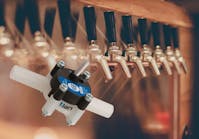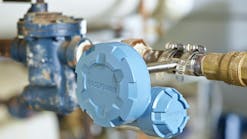The commercial benefits of effective food and beverage flow measurement
Measurement, monitoring and control of flow is pivotal to the efficiency and competitiveness of many of today’s industrial processes. From determining the volume of oil extracted from a well in the North Sea to controlling the uniformity of coating added to an acetaminophen tablet, the need to measure flow rate and related parameters such as density is universal. Despite the sheer breadth of applications, however, the fundamental measurement principles remain the same.
The sophistication and cost of measurement technologies varies across processes and industrial sectors according to the market need and fiscal value of the metered product. For example, flow measurement within the oil and gas sector is highly regulated due to end-product price and its taxation; therefore, low measurement uncertainty is paramount.
Contrast this with other industries that may be hesitant to adopt new measurement processes or technologies. This is often through a lack of understanding of flow measurement, including the required measurement uncertainty within their processes and the need for periodic traceable calibration of measurement instrumentation. Such hesitance represents a missed opportunity to reap the commercial benefits and maintain the regulatory compliance achievable through good measurement practices and infrastructure.
Fluid complexity
The food and beverage sector may not immediately spring to mind as warranting a high degree of flow measurement accuracy. Until, that is, you consider the complex nature of the fluids present in many products and the socioeconomic imperatives linked to certain products.
Accurate flow measurement of complex non-Newtonian fluids is required in the food and beverage processing sector. Fundamentally, accurate measurement underpins every aspect of manufacturing and distribution in the sector, and complex non-Newtonian fluids are found in most of the fluid handling, flow measurement and control applications. Due to the complexity of the fluid properties exhibited by non-Newtonian fluids, there are significant problems associated with fluid handling over and above those posed by standard Newtonian fluids such as water. This results in numerous factors that can affect the performance of density and flowmeters operating in these environments that are not present in typical Newtonian flow applications. Currently, limited research has been done in this area compared with the wealth of research and development carried out on the performance of density/flowmeters operating in Newtonian fluids, so characterization of the performance impact of non-Newtonian fluids is challenging — and exacerbated when fluid blends such as concentrated fruit juices or spreads are involved.
Lessons learned from other sectors
Many industrial processes require accurate measurement of the density of fluids for concentration determination, process control and evaluation of product quality. Density, defined as the mass per unit volume of a substance, is a physical property measured across multiple sectors from pharmaceutical processing to food and beverage processing to oil and gas processing. Densitometers and the density output of Coriolis flowmeters can be scaled to output directly in concentration units. Common applications within the food and beverage processing sector include the use of density for conversion from volumetric to mass flow and for inferring other properties such as the alcohol or sugar content of end products such as honey, alcoholic drinks and concentrated fruit juices.
In the pharmaceutical sector, conventional batch manufacturing of medicines is associated with excessive costs, high waste, rejections and delays. Continuous manufacturing is an emerging technology with the potential to transform the sector. It utilizes inline and online process analytical technology as a mechanism to design, analyze and control manufacturing processes with a high degree of automation through the measurement of critical process parameters that affect critical quality attributes.
A similar move toward a continuous production approach within the food and beverage sector could present new requirements for density measurement. The industry’s desire to move from traditional batch to continuous manufacturing may bring opportunity for online and inline density measurement in real time. However, despite its widespread use, inline and online density measurement is not currently well understood or adopted within the food and beverage sector. This is partly due to a relative lack of control and instrumentation, as well as flow and density measurement expertise, in comparison to sectors such as oil and gas.
Fiscal issues
Fiscal considerations create additional impetus for accurate density measurement of alcoholic beverages. For example, the U.K. tax authorities allow an uncertainty of 0.5% in the stated alcohol by volume (ABV) of drinks with an ABV between 1.2% and 5.5% for taxation (0.5% is an absolute value, so a 4% ABV beer, for example, can fall within the range 3.5%-4.5%). Online or inline densitometers and Coriolis mass flowmeters can easily achieve this uncertainty if properly calibrated to correct for annual drift. However, calibration challenges relating to hygiene, process throughput and a lack of measurement expertise mean offline density measurements are the preferred approach currently within the sector.
Unaddressed, %ABV determination through density mismeasurement could lead to noncompliance (through its underestimation) and a loss of revenue through incorrect taxation. From a simplistic perspective, before the COVID-19 pandemic, a 0.5% ABV measurement uncertainty on £4.9B of annual sales of Scotch whisky could have led to an exposure of £24.5M. The significance of measurement uncertainty was keenly illustrated when producers of a popular lager escaped a bill of more than £50M in 2017 due to its actual ABV falling within the permissible 0.5% uncertainty range of that stated on its cans and bottles.1 In the United States, the taxation of alcohol presents further consequences of mismeasurement as state-specific excise taxes on alcohol content can be levied in addition to underpinning federal taxes, thus compounding the tax liability.2
The introduction of a sugar tax (Soft Drinks Industry Levy) on fizzy soft drinks in the U.K. in April 2018 to tackle childhood obesity, tooth decay and diabetes further demonstrates the need for accurate density measurement within the food and beverage sector. Since then, manufacturers of these drinks have been subject to a charge of between 18-24 pence per liter of sugary drink produced depending upon the number of grams of sugar per 100 mL. A total levy of £336m for the 2019/2020 financial year shows there is much to be gained from accurate determination of added sugar concentrations for producers of premium and own brand soft drinks alike.3
The trend toward regulation of the food and beverage sector looks set to continue with calls from the public to extend the levy to fruit juices, milkshakes and alcoholic mixers.4 Furthermore, health campaigners are lobbying the U.K. government to apply minimum mandatory levies of 20% to confectionery products5 in a continued bid to improve health outcomes for the population. Salt content also cannot be too far from the radar as a future taxation target.
There is a clear need, therefore, for the global food and beverage production sector to increase its understanding of the need for traceable online/inline calibration of densitometers that will bring benefits through lower manufacturing costs, increased confidence in meeting the requirements of taxation authorities and the avoidance of under/overpayment of excise duties.
References
- Carling lager is 'weaker than advertised,' firm says in court - BBC News. https://www.bbc.com/news/uk-41059610.
- Alcohol Taxes on Beer, Wine, & Spirits: Federal & State. https://www.alcoholproblemsandsolutions.org/alcohol-taxes-on-beer-wine-spirits.
- Soft Drinks Industry Levy Statistics Commentary 2020 - GOV.UK (www.gov.uk).
- https://dentistry.co.uk/2020/06/10/three-five-uk-extend-sugar-tax.
- Confectionery industry should prepare for sugar tax extension. https://www.confectionerynews.com/Article/2018/02/21/Confectionery-industry-should-prepare-for-sugar-tax-extension.
Dr. Tracy Brown is head of life sciences and healthcare at TÜV SÜD National Engineering Laboratory, a world-class provider of technical consultancy, research, development, measurement and testing. Part of the TÜV SÜD Group, the company is also a global center of excellence for flow measurement and fluid flow systems and is the UK’s Designated Institute for Flow and Density Measurement.
Tracy Brown | Head of Life Sciences and Healthcare at TÜV SÜD National Engineering Laboratory
Dr. Tracy Brown is Head of Life Sciences and Healthcare at TÜV SÜD National Engineering Laboratory, a world-class provider of technical consultancy, research, development, measurement and testing. Part of the TÜV SÜD Group, the company is also a global center of excellence for flow measurement and fluid flow systems and is the UK’s Designated Institute for Flow and Density Measurement.



